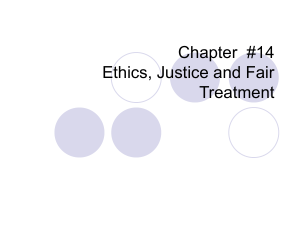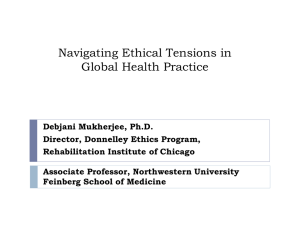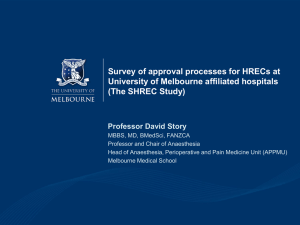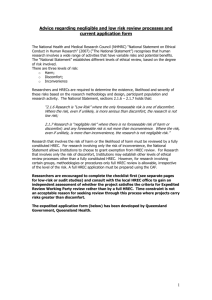A structured approach to ethical review of human research at UNSW
advertisement
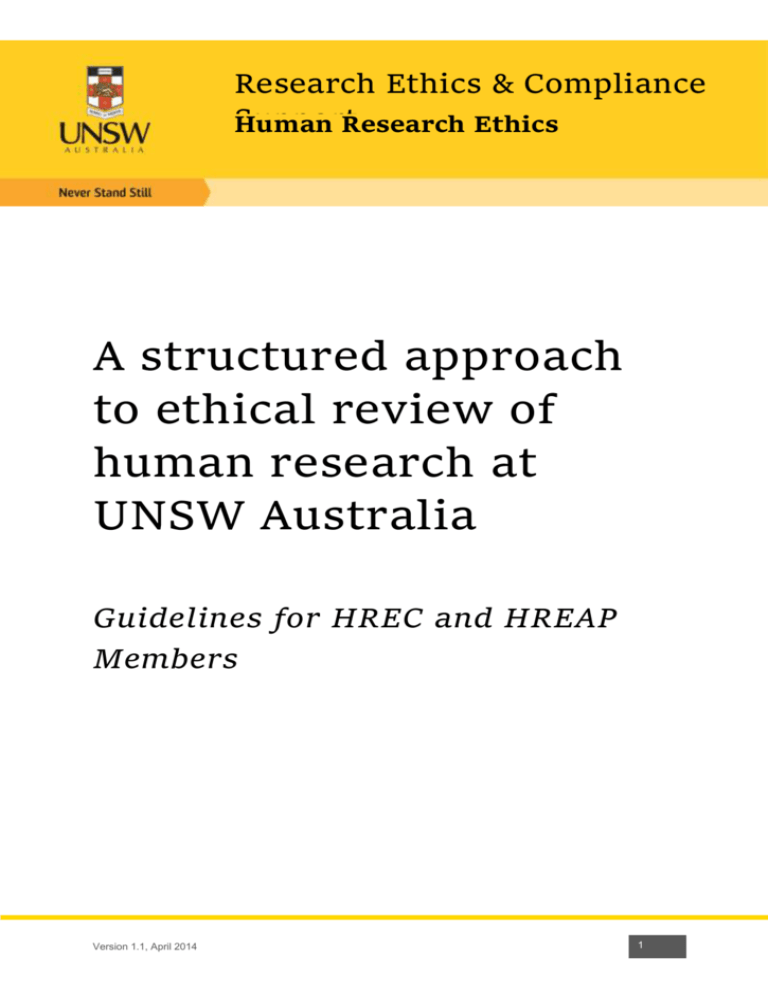
\ Research Ethics & Compliance Support Human Research Ethics A structured approach to ethical review of human research at UNSW Australia Guidelines for HREC and HREAP Members Version 1.1, April 2014 1 2 Contents Introduction ........................................................................................................................... 4 Consistency in research ethics review .................................................................................. 4 The National Statement ........................................................................................................ 5 The principles ....................................................................................................................... 5 Converting principles to review questions ............................................................................. 6 Research Merits ................................................................................................................ 6 Research Integrity ............................................................................................................. 7 Beneficence ...................................................................................................................... 7 Respect ............................................................................................................................. 7 Justice ............................................................................................................................... 8 Decision making.................................................................................................................... 8 Review tools ......................................................................................................................... 9 References and resources .................................................................................................. 10 Appendix 1: Review Template............................................................................................. 11 3 A structured approach to ethical review of human research at UNSW Australia Guidelines for HREC and HREAP Members Introduction Australian institutions, including UNSW Australia and its centres and collaborating institutions, that conduct research that involves human participants – human research – have responsibilities to ensure that the research is ethically reviewed. This essential responsibility is clearly stated in paragraph 5.1.1 of the National Statement on Ethical Conduct in Human Research, 2007 (updated March 2014), NHMRC, ARC and UA. (henceforth referred to as the National Statement). The National Statement is designed to clarify the responsibilities of institutions, researchers and review bodies (including low risk ethical review panels and human research ethics committees) for the ethical design, conduct and review of human research. The principles and processes contained in the National Statement apply to all Australian institutions that seek eligibility to receive research funds from either the National Health and Medical Research Council or the Australian Research Council. A challenge for UNSW and particularly its Human Research Ethics Committees (HRECs) and Human Research Ethics Advisory Panels (HREAPs) and their members is how to determine with certainty, and apply with reliability, the criteria for the review of human research that will meet the requirements of the National Statement. It is a challenge because the National Statement is a comprehensive document that contains guidance at more than one level of generality. The purpose of this guide is to identify within the National Statement a clear set of ethical review criteria that can provide clarity, reliability and consistency for the UNSW HRECs and HREAPs and their members who conduct ethical review and guidance for researchers who seek ethical clearance or approval of their projects. Consistency in research ethics review In most Australian universities, human research proposals that are submitted for ethical review vary greatly in research discipline, methodology and participants so that the issues of human research ethics and the outcome of their review will also vary widely. The same issue 4 may arise in different proposals but the resolution of those issues may be different. However, this variety should not excuse review bodies from functioning consistently. Consistency in human research ethics does not mean consistency in review outcome. Nor does it require that all members of review body think alike. It does mean consistency in always applying the same criteria: asking the same questions. This consistency gives assurance to researchers who can rely on all their proposals being subjected to the same criteria. It gives confidence to reviewers that the criteria they use have an authoritative source and it given reassurance to institutions that ethical review of their research meets national standards. The aim of this guide is to set out those criteria. The National Statement When a review body decides to approve a human research proposal the approval should contain an explicit statement that the proposal meets the requirements of the National Statement (National Statement, paragraph 5.2.22). The National Statement requirements that need to be fulfilled if human research is to be approved appear at three levels: values, principles and guidelines. The values appear on pages 11 to 12 of the National Statement and are described in brief general terms. The guidelines appear throughout the chapters related to types of research in section 3 and categories of participants in section 4. These are necessarily specific to particular research or participant contexts. The principles are the link between the values and the guidelines in that the principles reflect the values and the guidelines are applications of the principles to specific research contexts. Accordingly, the principles provide a practical statement of the requirements of the National Statement that need to be satisfied for the approval of a proposal for human research. The principles These are contained in a set of paragraphs and sub-paragraphs on pages 11-12 of the National Statement. 5 Each of the four values, Research Merit and Integrity, Justice, Beneficence and Respect is expanded into component principles. These provide a comprehensive set of criteria for ethical review of any human research proposal. In doing so, they form a basis on which researchers can demonstrate that their proposals should be approved and on which review bodies and their members can justify and explain their review decisions. Converting principles to review questions One risk of using the format and language of the principles on pages 11 and 12 of the National Statement is that they can become a mere checklist. An approach to the use by both researchers and review body members that takes the form of substantive questions for review bodies to answer can avoid such a superficial checklist approach. As an example, the second principle within the value of Research Merit and Integrity is: "(b) designed or developed using methods appropriate for achieving the aims of the proposal;" This can be expressed as a substantive question: "Why are the methods appropriate to achieve the aims of the proposal?" Constructed in this form, the criterion becomes a clear and essential question that a review bodies need to ask and researchers need to answer in their applications. The principles of the National Statement on one hand can lead to review questions on the other hand. On the following pages, the principles are all converted into such substantive questions. Research Merits i. ii. iii. iv. Justifiable by potential benefit can lead to the question ‘What is the benefit and why does the benefit justify research?’ Uses appropriate methods to achieve aims can lead to the question ‘Why are methods appropriate?’ Based on current knowledge in literature can lead to the question ‘What is current knowledge?’ Respect for participants not compromised by aims, methods or results can lead to the question ‘Why is respect not compromised?’ 6 v. vi. Conducted/supervised by those with appropriate experience, qualifications and competence can lead to the question ‘Why are experience, qualifications, and competence appropriate?’ Uses appropriate facilities and resources can lead to the question ‘Why are facilities and resources appropriate?’ Research Integrity i. ii. iii. iv. Searching for knowledge and understanding can lead to the question ‘What is the knowledge and understanding that the researchers are seeking?’ Following recognized principles of research conduct can lead to the question ‘What are the recognised principles of research conduct that the researchers will use?’ Conducting research honestly can lead to the question ‘How will the research be conducted honestly?’ Disseminating/communicating results, to permit public scrutiny and add to public knowledge/understanding can lead to the question ‘How will the results be disseminated to permit scrutiny and contribute to public knowledge and understanding?’ Beneficence i. ii. iii. iv. Likely benefit, to participants or community, must justify risks of harm/discomfort to participants can lead to the question ‘Why do likely benefits of the research justify any risks of harm or discomfort to participants?’ To design research to minimize risks of harm/discomfort can lead to the question ‘How does the design minimize the risk of harm/discomfort?’ To clarify potential benefits and risks can lead to the question ‘How are potential benefits and risks clarified for participants?’ For welfare of the participants can lead to the question ‘How will researchers fulfil their responsibility for welfare of participants?’ Respect i. ii. iii. iv. v. Requires due regard for the welfare, beliefs, perceptions, customs and cultural heritage, individual and collective can lead to the question ‘How does the research give due respect for welfare, beliefs, perceptions, customs and cultural heritage of participants?’ Respect for privacy, confidentiality and cultural sensitivities can lead to the question ‘How will researchers respect privacy, confidentiality and cultural sensitivities of participants?’ Giving due scope to capacity of human beings to make own decisions can lead to the question ‘How will the research give due scope to the capacity of participants to make their own decisions?’ Where participants are unable to make own decisions/have diminished capacity, respect involves empowering and providing protection can lead to the question ‘Where participants cannot make their own decisions, how will researchers empower and protect them?’ Voluntary participation based on sufficient information about and adequate understanding of purpose, methods, demands, risks and potential benefits of the 7 research (National Statement paragraph 2.2.2) can lead to the questions ‘Why is there sufficient information?’ and ‘Why will there be adequate understanding?’ Justice i. ii. iii. iv. v. vi. vii. Within the scope and objectives of research, selection, exclusion the inclusion of research participants is fair and accurately described can lead to the questions ‘Why are the selection, inclusion and exclusion criteria for the research fair?’ and ‘How will the selection methods be accurately described in the results?’ Process of recruiting participants is fair can lead to the question ‘Why is the recruitment process fair?’ No unfair burden of participation in research on groups can lead to the question ‘Why is there no unfair burden of participation on particular groups?’ Fair distribution of benefits of participation in research can lead to the question ‘How is the distribution of benefits of participation fair?’ No exploitation of participants can lead to the question ‘Why is there no exploitation of participants?’ Fair access to the benefits of research can lead to the question ‘How is access to the benefits of the research fair?’ Outcomes accessible to participants in timely and clear manner can lead to the question ‘How will timely and clear access to the outcomes of the research be provided to participants?’ Decision making Both HRECs and HREAPs have members with different knowledge, expertise and experience. The open exchange of differing opinions on whether a project meets the National Statement criteria outlined above is most likely to reach shared decisions that are ethically sound. For more than low risk applications decisions need to be derived from an exchange of opinions from at least each of the members who constitute the minimum membership (National Statement paragraph 5.2.29). The National Statement in paragraph 5.2.3 provides that members of review bodies, including HRECs and HREAPs, are responsible to: become familiar with this National Statement, and consult other guidelines relevant to the review of specific research proposals; and prepare for and attend scheduled meetings of the review body or, if unavailable, provide opinions on the ethical acceptability of research proposals before meetings, subject to institutional policies on absences. HREC Chairs and HREAP Convenors should facilitate reviews in such a way that all members have fair opportunities to contribute before a decision is reached. Chairs and Convenors need to remain aware of prior policy determinations and be willing to decide when expert advice is appropriate. 8 Essential elements of most HREC decisions are the determination of: to whom responses from investigators are to be referred; who will decide on their adequacy; and how a final approval decision will be reached. Where there is less than full attendance of the minimum membership at a meeting, the Chairs and Convenors have a specific responsibility to be satisfied, before a decision is reached, that the views of those absent who belong to the minimum membership have been received and considered (National Statement paragraph 5.2.30). Review tools There is value in adopting a structured approach to the conduct and/or the summary and recording of HREC deliberation. Doing so makes it more likely that the HREC/Panel addresses all the matters that need to be considered for the proposal under review. Reviews can be structured by nominating one or more member/s to introduce the discussion on a particular application and by using review guides and standard templates. Templates can be incorporated, in an abbreviated form, into a concise review guide for members of review bodies. Such review guides can facilitate communication by being arranged in the same order as the information is arranged in the application form that is used. An example of a guide is attached in Appendix 1 which can potentially be adapted to fit a particular application form. Participant information and consent forms (PICFs) often attract extensive discussion and comment in most research applications and changes are frequently required. The processes used to deal with changes to the PICF need to: avoid using the meeting time for insubstantial matters; achieve committee agreement on the substance of needed changes; and satisfy members that (1) the substance of all agreed changes will be incorporated into correspondence to investigators, and (2) in due time, that responses from investigators were satisfactory. 9 References and resources National Statement on Ethical Conduct in Human Research, 2007, updated March 2014, NHMRC, ARC, UA: https://www.nhmrc.gov.au/guidelines/publications/e72 Challenging Ethical Issues in Contemporary Research on Human Beings, 2007, NHRMC: http://www.nhmrc.gov.au/guidelines/publications/e73 Information & Privacy Commission NSW: http://www.ipc.nsw.gov.au/privacy/ipc_legislation.html Keeping research on track: a guide for Aboriginal and Torres Strait Islander peoples about health research ethics. 2006, NHMRC: http://www.nhmrc.gov.au/guidelines/publications/e65 Developing Best Practice in Human Research Ethics Review: http://docs.health.vic.gov.au/docs/doc/Developing-Best-Practice-in-Human-Research-EthicsReview University of Wollongong, on-line tutorial: http://www.uow.edu.au/research/rso/ethics/human/training/ Human Research Ethics information at UNSW can be found at: https://research.unsw.edu.au/research-ethics-and-compliance-support-recs For support and suggestions towards the content of this document please contact: 10 Research Ethics & Compliance Support Level 3, Rupert Myers Building South UNSW Australia Kensington Campus T: +61 2 9385 4235 E: humanethics@unsw.edu.au W: https://research.unsw.edu.au/research-ethics-and-compliance-support-recs Produced in Collaboration with Appendix 1: Review Template HREC/HREAP MEMBERS REVIEW GUIDE Meeting Date: Application Number: Application Title: Chief Investigator: Nature of Research: Section of Application Form Section 2.6: Sample Size Section 2.7: Recruitment (and Justice) (Participants) Comments & questions National Statement Reference Quantitative Research the size and profile of the sample is adequate to answer the research question 3.3.3 Qualitative Research is the sampling appropriate to the objectives and theoretical basis of the research 3.1.6 Selection, exclusion, inclusion fair 1.4 (a) No unfair burden 1.4 (c) Fair distribution of benefits of participation 1.4 (d) No exploitation 1.4 (e) Recruitment fair 1.4 (b) 11 Section 2.8: Project Description Sections 2.9 & 3.0 (Privacy) Justifiable by potential benefit 1.1 (a) Methods appropriate to achieve aims 1.1 (b) Based on current literature/prior studies 1.1 (c) Prior peer review?? 1.2 Design ensures respect 1.1 (d) See privacy addendum Section 3.4 Risks and Benefits to Participants (Risks and Benefits) Recruitment Materials PICFs Study Tools Potential benefits 1.6 Adequate disclosure 1.7 Fair access 1.4 (f) Results available 1.5 Risks of participation 1.7 (b), 2.1.3, 2.1.4 Risks managed and disclosed 1.7 (b), 2.1.3 Likely benefits justify risks 1.6, 2.1.5 Respect capacity to decide 1.12 Gives voluntary choice 2.2.1 Provide sufficient information 2.2.2 Relies on adequate understanding 2.2.2 Respect capacity to decide 1.12 Gives voluntary choice 2.2.1 Provide sufficient information 2.2.2 Relies on adequate understanding 2.2.2 Are appropriate tools to answer the research question The tools are appropriate for the target population Privacy Addendum (Section 2.9 & 3.0) Privacy Questions to consider 1. Collection – relates to the collection of health information How does the study comply? Will the researchers collect information that they won’t use in this study, but plan to use in future studies? Does the consent form accurately reflect all health information they are collecting and what it will be used for? Have the participants been informed 12 2. Use & Disclosure of health information – “Use” refers to the information being used internally within the research group. “Disclosure” refers to your research group giving the information to a separate body or organisation 3. Ensuring data quality – require health information to be accurate, complete, up to date & relevant to your study 4. Requirements for the security and retention of data 5. Transparency by documenting policies on the management of information and to make these policies available to the research participants they have the right to review their information? Is there a possibility anybody outside the research group will use the information they have collect without the person’s knowledge or consent? Does the research ask to disclose someone’s information to another research team/external body either within NSW, interstate or overseas? What processes are in place to ensure all information recorded is accurate and up to date? In what situations would this information be important? How are all types of study data stored? What processes are in place to ensure study data is not misused, lost or modified? How long is study data stored for? How will study data be destroyed? If a participant requests what information the research team holds about them can the research team tell them how to access it and what it has been used for? 6. Relates to access and correction of information 7. Limits on the assignment of identifiers that are intended to uniquely identify the participants in relation to their health information 8. Anonymity Is it possible for participants to remain anonymous in the study? Why/Why not? 9. Transborder dataflows Does the study involve sending information or samples outside of NSW? Does the PICF form clearly state any transborder data flow? Do the research team send any identifying information across borders? If a participant establishes that the information the researchers hold about them is inaccurate, incomplete, misleading or not up to date, how does the researcher go about correcting it? Does the research team assign study numbers to participants? What are the advantages/disadvantages of assigning a study number? 13



